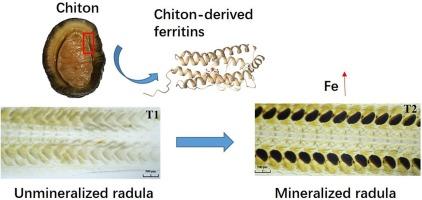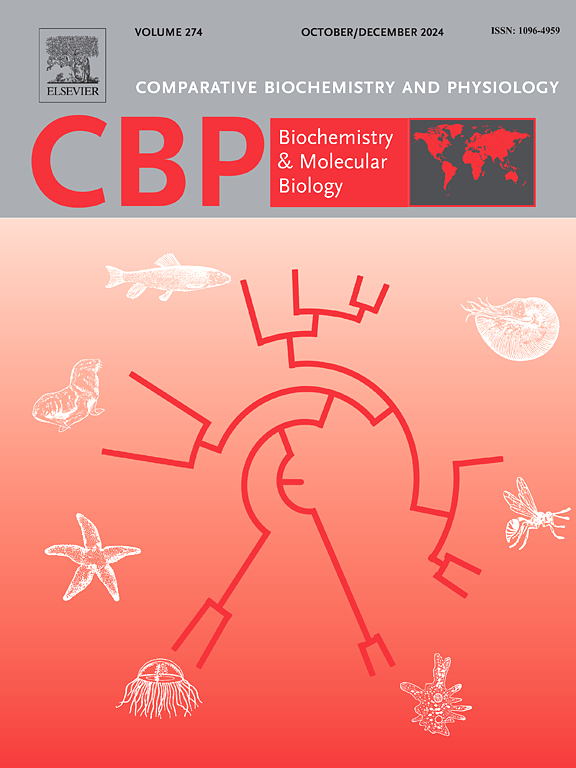Iron mineral formation using chiton-derived ferritins
IF 1.8
3区 生物学
Q4 BIOCHEMISTRY & MOLECULAR BIOLOGY
Comparative Biochemistry and Physiology B-Biochemistry & Molecular Biology
Pub Date : 2025-06-20
DOI:10.1016/j.cbpb.2025.111120
引用次数: 0
Abstract
The teeth of chitons, a group of marine mollusks, rank among the hardest biomaterials found on earth. These teeth are composed of structurally ordered iron oxide minerals. Ferritin is an iron-storage protein known to regulate iron metabolism across diverse organisms; however, its role in iron biomineralization in chiton teeth remains unclear. Herein, ferritins were isolated from chiton hemolymph. Transcriptome- and proteome-based analysis revealed that the main ferritins in chiton hemolymph are also found in chiton radulae, which is supported by their elevated transcriptional abundance in radular tissues. In vitro assays revealed that these ferritins can bind iron ions and promote the formation of iron-based minerals. Ex vivo experiments using unmineralized radular scaffolds further showed that chiton ferritins facilitate iron oxide biomineralization, although the resulting crystals differed structurally from the native magnetite found in mature teeth. Phylogenetic analysis confirmed the conservation of ferritins among chitons, indicative of their universal role in tooth formation in chitons. Our findings advance the molecular understanding of iron-based biomineralization in chitons and provide insights for the design of synthetic iron-based nanomaterials.

利用石壳衍生铁蛋白形成铁矿物。
石鳖是一种海洋软体动物,它们的牙齿是地球上发现的最坚硬的生物材料之一。这些牙齿是由结构有序的氧化铁矿物组成的。铁蛋白是一种铁储存蛋白,可以调节不同生物体的铁代谢;然而,其在石鳖牙齿铁生物矿化中的作用尚不清楚。本文从石鳖血淋巴中分离出铁蛋白。基于转录组学和蛋白质组学的分析表明,石鳖血淋巴中的主要铁蛋白也存在于石鳖结节组织中,这与它们在结节组织中的转录丰度升高有关。体外实验表明,这些铁蛋白可以结合铁离子,促进铁基矿物的形成。使用未矿化的根状支架进行的体外实验进一步表明,石壳铁蛋白促进氧化铁生物矿化,尽管所产生的晶体在结构上与成熟牙齿中发现的天然磁铁矿不同。系统发育分析证实了铁蛋白在石鳖中的保守性,表明铁蛋白在石鳖牙齿形成中的普遍作用。我们的发现促进了对石粒中铁基生物矿化的分子理解,并为合成铁基纳米材料的设计提供了见解。
本文章由计算机程序翻译,如有差异,请以英文原文为准。
求助全文
约1分钟内获得全文
求助全文
来源期刊
CiteScore
4.60
自引率
4.50%
发文量
77
审稿时长
22 days
期刊介绍:
Comparative Biochemistry & Physiology (CBP) publishes papers in comparative, environmental and evolutionary physiology.
Part B: Biochemical and Molecular Biology (CBPB), focuses on biochemical physiology, primarily bioenergetics/energy metabolism, cell biology, cellular stress responses, enzymology, intermediary metabolism, macromolecular structure and function, gene regulation, evolutionary genetics. Most studies focus on biochemical or molecular analyses that have clear ramifications for physiological processes.

 求助内容:
求助内容: 应助结果提醒方式:
应助结果提醒方式:


